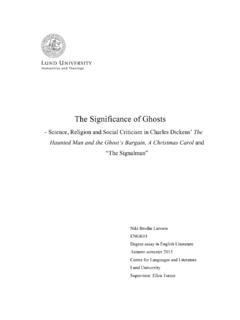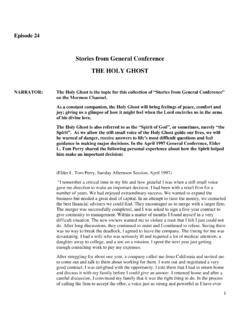Transcription of Investigation of the New Mexico State Penitentiary (Old Main)
1 Forward The word Investigation is defined as a searching inquiry for ascertaining facts; detailed or careful examination. The key word here is facts . Do ghosts exist? No, it has not been proven. Therefore are no facts to investigate. What we do have is the testimony of the witnesses and this is where an investigational process will work. Investigations are often viewed as a skeptical activity because the main goal is trying to determine what the witness actually saw. Is it explainable or not? This is done through critical thinking and an event replication process developed by SGHA. This is an important concept because what defines a haunting or ghost sighting is Multiple witnesses reporting unusual phenomena over a period of time . If these phenomena can be explained, the witness reports are no longer validating paranormal activity as a cause and thus there is no ghost or haunting.
2 Additionally historical research may be done in an attempt to validate facts. It is important to understand that the goal of an Investigation is not to find evidence of the paranormal but to attempt to identify any natural or manmade causes of the reported phenomena Definition of Terms Investigation Status: Unsolved investigations will have either an open or closed status. An Investigation is given an Open status if: The investigators were unable to replicate all of the witness events. Something significant remains that is still unsolved. It is important to understand that an open Investigation does not mean that the unsolved facts are paranormal in nature. It simply means that we have exhausted our resources and cannot solve the open items/events.
3 A Closed status indicates that there is insufficient data or confounding variables that prevents replication or identifying possible explanations. This often occurs when investigators do not have direct access to witnesses or some other environmental change have occurred that creates confounding variables. Confidentiality Notice Many of the witnesses interviewed have wished to remain anonymous in exchange for presenting their accounts of paranormal experiences. We honor that request and thus witnesses will often be identified by aliases. Any coincidence between aliases and actual persons is unintentional. Contents Part 1: Location Information .. 4 Part 2: Location History .. 4 Part 3: Witnesses.
4 10 Part 4: Reported Phenomenon .. 12 Part 5: Investigation .. 13 Part 6: Myth Building .. 20 Part 7: The 94 Rock ghost Hunt at the prison (2002) .. 20 Part 8: Conclusion .. 26 Part 1: Location Information New Mexico State Penitentiary (Old Main) Santa Fe, NM Part 2: Location History Opened in 1885, the New Mexico Penitentiary had been authorized by Congress since 1853. The design was based on the same plans used for Sing Sing and Joliet. The first prison industry produced bricks. Beginning in 1903, New Mexico became the first western State to employ prisoners in building highways. On 19 July 1922, prisoners at the pen rioted against overcrowding, the poor food, and the use of excessive force by the prison authorities.
5 [8] When the inmates refused to return to their cells, the tower guards opened fire, killing one inmate and injuring five others. In the report following the riot, the prison authorities were blamed for lack of experience, and failure to understand how to control a prison population. The second riot was 15 June 1953. Inmates protesting the use of excessive force seized Deputy Warden Ralph Tahash and twelve guards and held them hostage. In the resulting melee, guards killed two inmates and wounded a number of others. This second riot led to the abandonment of the original facility as a prison and the construction in 1956 of what came to be called "the main unit".
6 In 1980, Cell Block 4, "the main unit", was the scene of one of the most violent prison riots in the correctional history of America. Over two days 33 inmates were killed and 12 officers were held hostage by prisoners who had escaped from cell blocks in the main unit. Men were brutally butchered, dismembered, and decapitated and hung up on the cells and burned alive. This section of the prison was closed in 1998 and is now referred to as the "Old Main."1 The 1980 Riot It was an inmate rebellion without a plan, without leadership and without goals. There were few heroes, plenty of villains and many victims. When State Police marched into the Penitentiary of New Mexico on Feb. 3, 1980, they didn't retake the prison from rioting inmates so much as they occupied the charred shell after the riot had burned itself out.
7 Thirty-three inmates were found dead inside -- some of them horribly butchered by their fellow prisoners. The emergency room at St. Vincent Hospital in Santa Fe was overwhelmed with more than 100 inmates -- some beaten, others suffering from drug overdoses. Eight of the 12 guards who had been taken hostage were treated for injuries. Surprisingly, none of the guards was killed. It was a 1 black mark on New Mexico history as the nation was captivated by the horror stories that dribbled out of Santa Fe. The riot began in the early morning hours of Saturday, Feb. 2, when guards entered dormitory E-2 on the south side of the Prison.
8 The door to the dormitory wasn't locked, in violation of prison security procedures. Neither was a hallway gate that led to the prison control room. Four guards were taken hostage during the first few minutes of the riot. In all, there were 15 guards on duty inside the prison that night, supervising more than 1,100 inmates. Inmates rushed down the main corridor and broke the shatterproof glass at the control center. The guard on duty fled, leaving behind keys that could open most of the prison gates and doors. The inside of the prison became a nightmare of violence. One Associated Press reporter later described it in a story distributed worldwide as a "merry-go-round gone crazy.
9 " Fires were set. Inmates ripped out plumbing fixtures, flooding parts of the prison. Other inmates got into the infirmary and began taking drugs. Others began hunting their enemies, and found them. Sometime around 8 that Saturday morning, inmates began using tools from the prison to gain access to cellblock 4, which housed the "snitches" and inmates in protective segregation. The "snitches" met a horrible end. One was hung from the upper tier of the cellblock, another decapitated. Most of the 33 inmates killed were from the segregation unit. Early Saturday morning, fitful negotiations began with some inmate leaders. Ambulances shuttled the dead and injured to St.
10 Vincent. Smoke poured out of the prison gymnasium. It became clear later that neither the inmates nor the State had a single spokesman during the negotiations. Eventually, inmates made 11 basic demands. Some concerned basic prison conditions like overcrowding, inmate discipline, educational services and improving food. They also wanted outside witnesses -- federal officials and the news media. Hostage guards were released. Some of the guards had been protected by inmates; others were brutally beaten. "One was tied to a chair. Another lay naked on a stretcher, blood pouring from a head wound," a Journal reporter wrote. Negotiations broke off about 1 Sunday and State officials insisted no concessions had been made.









